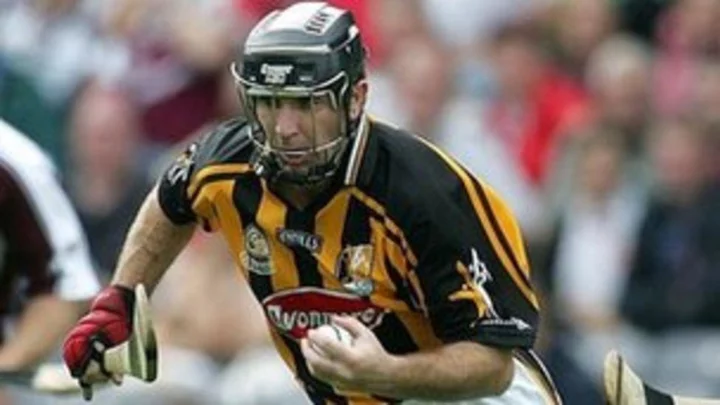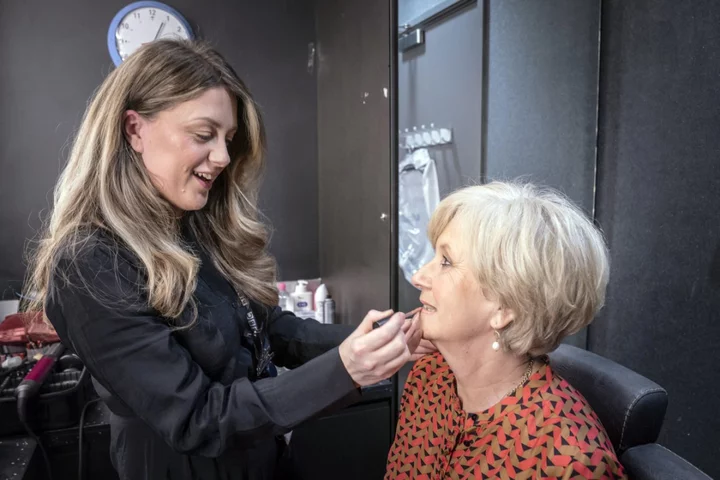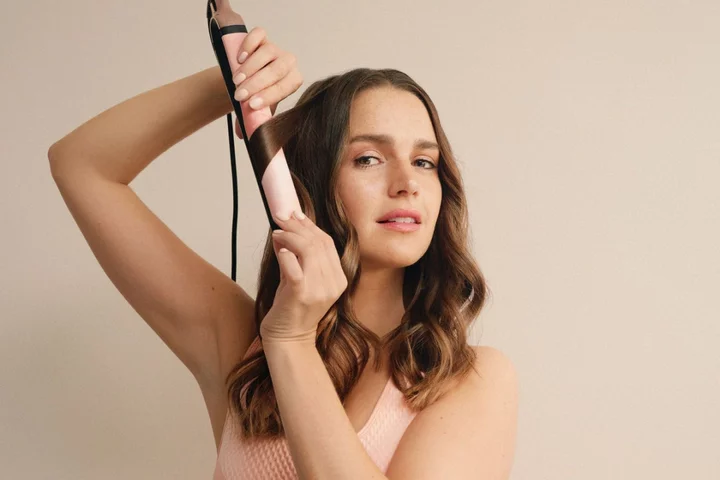
FPL Gameweek 7: Top captain picks
The top captaincy picks for FPL Gameweek 7 as selected by AI. Powered by Fantasy Football Hub.
1970-01-01 08:00

Factbox-European countries who put curbs on Huawei 5G equipment
Germany last week became the latest European country to propose restrictions or bans on the use of equipment
1970-01-01 08:00

Hurling star DJ Carey accused of cancer cash fraud
DJ Carey is accused of inducing people to pay him money after fraudulently claiming to have cancer.
1970-01-01 08:00

The exact time Brits find themselves ‘uncontrollably hungry’ revealed
One in four Brits find themselves uncontrollably hungry by 10:30 am, research has found. A study of 2,000 adults found they typically snack twice a day, with sausage rolls, crisps, biscuits and bananas the most popular choices. But 27 per cent get the munchies by mid-morning, and a third have even got out of bed for a midnight snack. Other popular treats include chocolate bars, nuts, cake and crackers. A spokesman from Wall’s, which commissioned the research as part of its ‘When hunger calls, grab a Wall’s’ campaign, said: “Sometimes a snack can be an absolute saviour to your day as the research has shown. “Uncontrollable hunger at times can absolutely take over and leave you unable to get on with your day until it’s been satisfied. “And there’s real enjoyment taken from ridding of this hunger whenever it strikes with a snack never being far away.” The study also found 23 per cent of adults don’t usually have breakfast, with 36 per cent of those claiming they are more prone to snacking as a result. When watching TV, over the weekend and in the workplace were the most common times and places to chomp on a treat. And more than £10 is spent on them in a typical week, according to the OnePoll data. More than seven in 10 (73 per cent) have snacks stocked up in their homes for when they need them, and 25 per cent have hidden them from loved ones. While 21 per cent have a dedicated drawer in their workplace for keeping them for when hunger calls. The importance of a snack cannot be underestimated though as 60 per cent believed a great treat can save a rubbish day. To avoid a bad day, 33 per cent will typically pack one for themselves when leaving the house. However, 20 per cent have been made to feel guilty about their snacking habits with others pointing out the frequency they so do. A spokesperson from Wall’s [https://www.instagram.com/wallspastry], added: “Hunger can be overpowering and there’s nothing worse than being caught short and having nothing to hand. “However, there’s no better feeling than finally chomping on something after having been hungry for a while and satisfying that desire. “Snacks such as sausage rolls are a great and versatile option for when hunger calls.” Top 20 most popular snacks, according to Brits: 1. Crisps 2. Biscuits 3. Chocolate bar 4. Banana 5. Nuts 6. Cookies 7. Cake 8. Toast 9. Apple 10. Grapes 11. Crackers 12. Cereal bar 13. Yoghurt 14. Sausage roll 15. Orange/satsuma 16. Cereal 17. Doughnut 18. Berries 19. Flapjack 20. Popcorn Read More Smoking during pregnancy doubles premature birth risk, study finds Four in ten Brits ignore potentially serious eye problems, study finds Study finds women only give themselves 30 minutes of self-care a week Children avoid sleepovers due to fears of wetting the bed Most unwanted gifts people have received The best napping method to help with pulling an all-nighter
1970-01-01 08:00

Gwen Stefani's stage makeup is her 'armour'
Gwen Stefani finds doing her own makeup for concerts "very therapeutic".
1970-01-01 08:00

ABBA's Agnetha Faltskog and Gary Barlow share new version of I Should’ve Followed You Home
Agnetha Faltskog and Gary Barlow first released the song a decade ago.
1970-01-01 08:00

This is how your make-up needs change as you age
Whether you’re in your 30s or your 60s, your skin probably doesn’t look and feel like it did at the age of 20 – and that’s OK. But if you’ve barely upgraded the make-up you’ve been using for years, it might be time to do so. “As we age, our skincare and make-up needs change, and it’s important to adapt our beauty routines to address the specific concerns that come with each decade,” says Co. Kildare-based make-up artist Suzie O’Neill, owner of vegan cosmetics company Ayu. Over time, your skin loses elasticity and oils, so in all age groups solid skincare is key. “Regardless of age, a good skincare routine is essential for a smooth make-up application,” O’Neill says. “Prioritise moisturising and using sunscreen daily.” She advises using products rich in vitamins A, C and E – to protect the outermost layer from water loss in your 30s, a decade where “skin becomes more delicate and cell turnover is slowing down, making your complexion look dull”. So how should we switch up our make-up in our 40s and beyond? In your 40s Collagen and elastin production naturally decrease during this period, leading to a reduction in skin firmness and elasticity in your 40s, O’Neill says. To combat this, she recommends incorporating a serum with ingredients like hyaluronic acid, peptides and retinol, which can help stimulate collagen production. Foundation is the most important make-up upgrade to make at this period of your life. “Your 40s are the ideal time to switch to a foundation that is more hydrating and lighter than what you might have used in your 20s and 30s. Heavy, matte foundations tend to settle into fine lines and wrinkles, which can accentuate them. A hydrating and lighter foundation is a better choice as your skin may become drier and more mature.” O’Neill advises using a moisturising lipstick or balm to keep lips hydrated, as they can start to become drier at this time in our lives. “The cumulative effects of sun exposure can become more apparent in your 40s, leading to pigmentation issues, fine lines and potential sunspots,” she adds. So a broad-spectrum sunscreen is “non-negotiable”. In your 50s When it comes to make-up, your 50s may be a time when you opt for a more natural look. “A light to medium coverage foundation or a tinted moisturiser [will] not only provide a subtle, youthful glow, but also allow the natural character of the skin to shine through,” notes O’Neill. “Less is often more at this stage.” She recommends focusing on techniques that lift and brighten the eyes. “For example, tight-lining – applying eyeliner to the upper waterline – can make lashes appear thicker and eyes more prominent. Apply eye make-up with a light hand and choose softer, neutral shades that open up the eyes and give them a more refreshed appearance.” It’s common for lips to appear to lose volume by our 50s, so O’Neill suggests using a lip liner in a shade closely matching your natural lip colour. “It can work wonders by creating the illusion of fuller, more voluptuous lips. “Eyebrows and eyelashes tend to thin out as we age; filling in sparse brows with a brow pencil or powder and using volumising mascara can help restore the appearance of full, youthful brows and lashes.” In your 60s and beyond As you enter your 60s, you could opt for warmer hues. “As our skin naturally loses some of its warmth and pigmentation, opting for a foundation with warmer undertones can help counteract any sallowness that may occur,” says O’Neill. “[But] choosing a foundation that matches your skin tone as closely as possible is essential.” You also might notice an increase in pigmentation irregularities on your skin. “To even out pigmented skin, I’d recommend using a colour-correcting concealer for spots and discolourations (orange or peach-toned concealers can help neutralise dark spots) followed by a lightweight foundation or BB cream to even out skin tone,” she says. “Use setting powders sparingly as they can emphasise fine lines. Opt for a finely milled, translucent powder applied lightly only where needed.” And don’t be afraid to experiment with colour in your 60s. “Using more colour can be a great way to combat dullness that often accompanies ageing skin. “Brighter shades of make-up, such as lipsticks, eyeshadows, and blush, can help liven up your complexion.” Blush can help brighten up your skin, with O’Neill recommending cream versions as “they tend to blend more seamlessly and provide a dewy, hydrating finish”, and can be easily applied with your fingers. “Just remember to choose shades that complement your skin tone and apply them sparingly for a natural flush,” she adds. As you age, splurging on make-up isn’t a must, she says, but investing in high-quality make-up products that cater to your specific needs can be beneficial. “Look for products that provide essential hydration [and] achieve a luminous glow. “The key is to enhance your natural beauty rather than mask it.” Read More Charity boss speaks out over ‘traumatic’ encounter with royal aide Ukraine war’s heaviest fight rages in east - follow live Victorian dahlia show recreated at Stonehenge with thousands of flowers Daily activities could help lower heart attack risk, study suggests From tiredness to sweating – subtle warning signs something could be wrong with your heart
1970-01-01 08:00

Daily activities could help lower heart attack risk, study suggests
Everyday activities like walking up the stairs or playing with children could help lower the risk of heart attack, stroke and even premature death, new research suggests. The experts found that although short bouts of incidental activity are good for you, the how long you do them for, and how vigorously makes a difference. The findings may make physical activity much more accessible to people who are unwilling or unable to take part in structured exercise, researchers say. They found that the longer the bouts of activity, the better, regardless of total activity levels. The large majority (97%) of this everyday physical activity, like walking to the bus stop or household chores, was made up in bouts lasting less than 10 minutes. In a group of people who said they did not take part in exercise or sport, short bouts of less than 10 minutes at a moderate to vigorous intensity were associated with a steep decrease in heart attack and stroke, and death by any cause. According to the findings, moving consistently for at least one to three minutes was linked to significantly more benefit (29% lower) than very short bouts of movement that lasted less than one minute. Senior author Professor Emmanuel Stamatakis from the University of Sydney’s Charles Perkins Centre, in Australia, said: “From walking up the stairs to speedily mopping the floors, in recent years we’ve come to understand that it is not just structured exercise that is good for our health, but we know very little about how these short bouts of incidental activity translate to health benefits.” He added: “The take-home message here is any type of activity is good for your health, but the more effort you put into those daily tasks and the longer you keep up that energy, the more benefits you are likely to reap. “If you are huffing and puffing and unable to hold a conversation for some of that time you have hit the sweet spot.” Lead author Dr Matthew Ahmadi said: “The idea of accruing short bouts of moderate to vigorous activity through daily living activities makes physical activity much more accessible to people who are unwilling or unable to take part in structured exercise. But as we see in this data, the length and the vigour people put into these incidental activities matters.” The risk of all-cause death and major cardiovascular events (heart attack or stroke) was 29-44% lower for activity periods of five minutes to less than 10 minutes, than bouts of less than one minute. The study, published in The Lancet Public Health, also found that the higher the amount of vigorous activity in each bout the better. People who huffed and puffed for at least 15% of the activity period (10 seconds per minute) saw the greatest benefit. Bouts of less than one minute were also associated with benefits if the above 15% vigorous activity rule was applied, researchers found. The researchers used data from wrist devices worn by 25,241 people aged 42 to 78, in the UK Biobank database, and artificial intelligence to analyse the seven-day physical activity patterns in people who said they did not exercise. The study linked these physical activity patterns with health records, following people for close to eight years to identify how length and intensity of physical activity bouts were linked to health status. Dr Ahmadi added: “This study suggests people could potentially reduce their risk of major cardiac events by engaging in daily living activities of at least moderate intensity where they are ideally moving continuously for at least one to three minutes at a time. “In fact, it appears that this can have comparable health benefits to longer bouts lasting five to 10 minutes.” Read More Charity boss speaks out over ‘traumatic’ encounter with royal aide Ukraine war’s heaviest fight rages in east - follow live From tiredness to sweating – subtle warning signs something could be wrong with your heart Breast Cancer Awareness Month: 9 brilliant beauty buys supporting good causes Smokers 2.6 times more likely to give birth prematurely
1970-01-01 08:00

From tiredness to sweating – subtle warning signs something could be wrong with your heart
People can go years with no idea they have something wrong with their heart. Symptoms can be vague and subtle and many heart conditions are ‘hidden’ – meaning they’re not obvious from the outside. “Hidden heart conditions often go undiagnosed for too long, until something goes wrong or it’s too late,” says Sindy Jodar, senior cardiac nurse at the British Heart Foundation (BHF). “That’s why it is important to never ignore the signs of heart disease and get yourself checked, just to be sure.” While some warning signs are easy to spot – such as severe chest pain and collapse – there are also many little indicators that something could be wrong with your heart or circulatory system. These won’t necessarily mean you have a heart problem, but it’s always best to have them investigated. From tiredness and nausea to fainting, here are some of the less obvious symptoms everyone needs to know about… 1. Feeling unusually tired Dr M Adil U Khan, a GP at Pall Mall Medical, says you should not “ignore or downplay unusual levels of tiredness”. While it’s normal to feel exhausted if you’ve been very busy or lacking sleep, he adds: “Feeling unusually tired, especially if it’s not related to exertion, should be investigated.” It could be due to something like anaemia, a virus, or even linked to mental health. It could also be related to your heart, so it is important to have it investigated. 2. Subtle discomfort “Look out for subtle discomfort in different areas of your body, including discomfort or pain in the jaw, neck, back, or stomach, which can be associated with a heart problem,” says Khan. If symptoms are out of the norm for you and aren’t going away, it’s always best to get them checked. 3. Unusual swelling Perhaps you have noticed your ankles look particularly puffy, or maybe it’s your general tummy area that’s constantly swollen for no apparent reason. “Unexplained swelling, known as oedema, in the legs, ankles or abdomen, may also be signs of heart failure,” explains Khan. 4. Vomiting and a choking sensation Sudden vomiting or a choking sensation in your throat is something to be wary of too. “While not every bout of nausea means there could be something serious happening, feeling sick combined with other aches and pains, such as severe chest pain, should ring an alarm bell,” says Jodar. Yes, it could be a stomach bug, but if you are having sudden spells of vomiting and nausea more regularly and you’re not sure why, don’t delay in get things checked out. 5. Fainting If you experience sudden fainting, this is a big indicator of something being awry. “If fainting or any other symptom becomes a problem, consult a healthcare provider and schedule an appointment with a doctor or cardiologist,” says Khan. “Discuss your symptoms, medical history and risk factors with them. “Your healthcare provider will assess your vital signs and perform a physical examination. Depending on your symptoms and risk factors, you may undergo diagnostic tests like ECGs, echocardiograms, stress tests, blood tests, or more specialised cardiac assessments,” he adds. 6. Shortness of breath Struggling to catch your breath is not a trivial matter. “Anyone experiencing shortness of breath during everyday activities or at rest should see their doctor,” says Khan. This is especially the case if it’s accompanied by chest pain – even if it doesn’t seem especially severe. Khan adds: “Mild chest discomfort should always be investigated, but some people mistake this for indigestion or muscular pain.” 7. Unusual sweating “Feeling hot, clammy and quite sweaty when you haven’t been doing strenuous exercise shouldn’t be ignored,” adds Jodar. “If this is combined with chest pains, it’s important you get yourself looked at.” 8. Heart rate irregularities Does your pulse sometimes feel jumpy or too fast? Get it checked with your doctor. Khan says: “Smartwatches and fitness trackers can provide valuable data about your heart rate and may detect irregularities to some extent. They can help track general trends in heart rate, especially during physical activity or rest. “However, they are not a substitute for medical-grade monitoring and evaluation… Any concerning symptoms should be evaluated by a healthcare professional for a comprehensive assessment and diagnosis,” Khan adds. Read More Charity boss speaks out over ‘traumatic’ encounter with royal aide Ukraine war’s heaviest fight rages in east - follow live Breast Cancer Awareness Month: 9 brilliant beauty buys supporting good causes Smokers 2.6 times more likely to give birth prematurely Female students ‘more than twice as likely’ to be affected by poor mental health, research shows
1970-01-01 08:00

Factbox-Evergrande founder joins list of Chinese tycoons investigated, arrested
The founder of China Evergrande, the world's most indebted property developer, is being investigated for "illegal crimes", a
1970-01-01 08:00

Breast Cancer Awareness Month: 9 brilliant beauty buys supporting good causes
A wave of pink products washing over the beauty world can only mean one thing: Breast Cancer Awareness Month is back. This October, with the Barbie pink trend still going strong, there’s even more reason to snap up a rose-tinted treat for yourself or a loved one. From nail polish and make-up to skincare and hair tools, here’s our pick of this year’s best charitable beauty buys… 1. Mavala Limited edition Power of Pink Mini Colour Pink Pastel, £6.40, LookFantastic For the third year running, Mavala unveils its Power of Pink range of skincare and nail varnishes, with £1 from the sale of each product going to the Pink Ribbon Foundation. We love the Power of Pink Pastel polish, a cute ballerina-pink shade that suits everyone. 2. Trinny London Sherin Lip2Cheek, £26 Fans of TV presenter turned beauty entrepreneur Trinny Woodall’s eponymous brand love the versatility of the creamy Lip2Cheek pots, which can be used as blusher, lipstick or eyeshadow. Named after Trinny London customer Sherin, who is living with secondary breast cancer, this shade is a warm brown. For every pot sold, 10% of sales will be donated to Breast Cancer Now. 3. Bobbi Brown Powerful Pinks Crushed Oil Infused Gloss Duo, £38 Bobbi Brown’s luscious lip gloss duo, worth £50, brings together two botanical oil-infused pink hues, with proceeds going to the Breast Cancer Research Foundation (BCRF). Soft peachy-pink In The Buff is perfect for everyday wear while plummy Slow Jam is an ideal evening option. 4. Clinique Limited Edition Moisture Surge 100H Auto-Replenishing Hydrator, £40 If you’re yet to try Clinique’s incredible Moisture Surge, now’s the perfect time to experience the lightweight but ultra-hydrating day cream loved by beauty buffs. For every pot of the limited edition sold, £10 will be donated to the BCRF. 5. Philip Kingsley No Scent No Colour Duo Shampoo and Conditioner, £42.24 (was £48) Inspired by trichologist Philip Kingsley’s wife’s battle with breast cancer, these fragrance-free essentials were formulated for use during chemotherapy. Ideal if you’ve got sensitive skin or dandruff, they contain salicylic acid and green tea extract to promote scalp health. For every bottle sold, 50p will go to cancer charity Look Good Feel Better 6. Estee Lauder Pink Ribbon Advanced Night Repair Serum Limited Edition, £89 Devotees of Estee Lauder Advanced Night Repair – one of the first skincare serums, launched back in 1982, and still a bestseller – love its rejuvenating, collagen-boosting powers. For October, the usually brown bottle gets a hot pink transformation, with a 20% donation from sales going to BCRF. 7. Elemis Pro-Collagen Rose Micro-Serum, £90 Packed with rose-infused microdroplets, this dual-phase serum works to strengthen the skin barrier, hydrate the skin and reduce the appearance of fine lines. For every serum sold, Elemis is donating £10 to Look Good Feel Better in support of their workshops and services. 8. Jo Malone Peony & Blush Suede Cologne, £118 for 100ml A long-time supporter of BCA month, Jo Malone this year introduces a special edition of the classic Peony And Blush Suede Cologne, with £20 from every bottle sold going to the BCRF. Decorated with a floral print and a pink ribbon, the fragrance features notes of red apple, pink peony, jasmine and rose. 9. GHD Platinum+ Styler Pink Limited Edition, £239 For creating poker-straight strands or glossy waves, the GHD Platinum+ with hair-protecting technology is second to none. This marbled pink limited edition comes with a free zip-up pouch, with £10 for each sale going to Breast Cancer Now or €10 to the Irish Cancer Society. Read More Charity boss speaks out over ‘traumatic’ encounter with royal aide Ukraine war’s heaviest fight rages in east - follow live Smokers 2.6 times more likely to give birth prematurely Female students ‘more than twice as likely’ to be affected by poor mental health, research shows Many parents of under 5s on less than £50k ‘quit work due to childcare costs’ – survey
1970-01-01 08:00

Trudeau says serious about Canada's relations with India despite row
The Canadian PM said India was an important geopolitical and economic power.
1970-01-01 08:00
